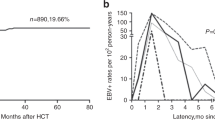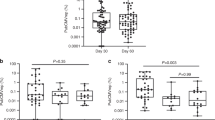Abstract
EBV reactivation is a serious complication affecting the recipients of allogeneic haematopoietic stem cell transplants (allogeneic HSCT). Recent reports have suggested that EBV reactivation induces increased expression of C-C chemokine receptor-5 (CCR5) or its ligands. Therefore, the 32-nucleotide deletion within the CCR5-encoding gene (CCR5Δ32 polymorphism) was analysed in 92 recipients of allogeneic HSCT and their donors and related with EBV load. In addition in 30 patients, at the same time points employing a real-time PCR technique, the number of viral copies and CCR5 transcripts were assessed. The incidence of EBV reactivation 2–3 months after transplantation was significantly lower in patients carrying the CCR5Δ32 allele (P=0.008). The association was confirmed in multivariate analysis, in which recipient CCR5Δ32 (OR=0.166, P=0.026) in addition to recipient age (OR=1.536, P=0.034) were identified as independent risk factors for EBV reactivation. Moreover, EBV reactivation was more frequently seen when patients and their donors were lacking the CCR5 deletion mutation as compared to other donor–recipient pairs (P=0.022). The CCR5 expression was significantly higher in the group of patients having EBV reactivation than in those lacking it (R=25.354, P=0.024). These results suggest that the expression of functional CCR5 plays a role in initiation/perpetuation of EBV reactivation.
This is a preview of subscription content, access via your institution
Access options
Subscribe to this journal
Receive 12 print issues and online access
$259.00 per year
only $21.58 per issue
Buy this article
- Purchase on Springer Link
- Instant access to full article PDF
Prices may be subject to local taxes which are calculated during checkout

Similar content being viewed by others
References
Lusso P . HIV and the chemokine system: 10 years later. EMBO J 2006; 25: 447–456.
Wald O, Pappo O, Ari ZB, Azzaria E, Wiess ID, Gafnovitch I et al. The CCR5Δ32 allele is associated with reduced liver inflammation in hepatitis C virus infection. Eur J Immunogenet 2004; 31: 249–252.
Venkatesan S, Petrovic A, Van Ryk DI, Locati M, Weissman D, Murphy PM . Reduced cell surface expression of CCR5 in CCR5Δ 32 heterozygotes is mediated by gene dosage, rather than by receptor sequestration. J Biol Chem 2002; 277: 2287–2301.
Uchihara JN, Krensky AM, Matsuda T, Kawakami H, Okudaira T, Masuda M et al. Transactivation of the CCL5/RANTES gene by Epstein-Barr virus latent membrane protein 1. Int J Cancer 2005; 114: 747–755.
Zaunders JJ, Kaufmann GR, Cunningham PH, Smith D, Grey P, Suzuki K et al. Increased turnover of CCR5+ and redistribution of CCR5-CD4T lymphocytes during primary human immunodeficiency virus type 1 infection. J Infect Dis 2001; 183: 736–743.
Trautmann A . Chemokines as immunotransmitters? Nat Immunol 2005; 6: 427–428.
Przepiorka D, Weisdorf D, Martin P, Klingemann HG, Beatty P, Hows J et al. 1994 Consensus conference on acute GVHD grading. Bone Marrow Transplant 1995; 15: 825–828.
Smith KM, Crandall KA, Kneissl ML, Navia BA . PCR detection of host and HIV-1 sequences from archival brain tissue. J Neurovirol 2000; 6: 164–171.
Wang FZ, Dahl H, Linde A, Brytting M, Ehrnst A, Ljungman P . Lymphotropic herpesviruses in allogeneic bone marrow transplantation. Blood 1996; 88: 3615–3620.
Hoshino Y, Kimura H, Tanaka N, Tsuge I, Kudo K, Horibe K et al. Prospective monitoring of the Epstein-Barr virus DNA by a real-time quantitative polymerase chain reaction after allogeneic stem cell transplantation. Br J Haematol 2001; 115: 105–111.
Bogunia-Kubik K, Mlynarczewska A, Jaskula E, Lange A . The presence of IFN-γ 3/3 genotype in the recipient associates with increased risk for EBV reactivation after allogeneic haematopoietic stem cell transplantation. Br J Haematol 2006; 132: 326–332.
Laichalk LL, Hochberg D, Babcock GJ, Freeman RB, Thorley-Lawson DA . The dispersal of mucosal memory B cells: evidence from persistent EBV infection. Immunity 2002; 16: 745–754.
Vassiliadou N, Tucker L, Anderson DJ . Progesterone-induced inhibition of chemokine receptor expression on peripheral blood mononuclear cells correlates with reduced HIV-1 infectability in vitro. J Immunol 1999; 162: 7510–7518.
Pfaffl MW . A new mathematical model for relative quantification in real-time RT-PCR. Nucleic Acids Res 2001; 29: e45.
Pfaffl MW, Horgan GW, Dempfle L . Relative expression software tool (REST) for group-wise comparison and statistical analysis of relative expression results in real-time PCR. Nucleic Acids Res 2002; 30: e36.
Razonable RR, Paya CV . Herpesvirus infections in transplant recipients: current challenges in the clinical management of cytomegalovirus an Epstein-Barr virus infections. HERPES 2003; 10: 60–65.
Murai M, Yoneyama H, Ezaki T, Suematsu M, Terashima Y, Harada A et al. Peyer's patch is the essential site in initiating murine acute and lethal graft-versus-host reaction. Nat Immunol 2003; 4: 154–160.
Bogunia-Kubik K, Duda D, Suchnicki K, Lange A . CCR5 deletion mutation and its association with the risk of developing acute graft-versus-host disease after allogeneic hematopoietic stem cell transplantation. Haematologica 2006; 91: 1628–1634.
Molon B, Gri G, Bettella M, Gomez-Mounton C, Lanzavecchia A, Martinez C et al. T cell costimulation by chemokine receptors. Nat Immunol 2005; 6: 465–471.
Holler E . Cytokines, viruses, and graft-versus-host disease. Curr Opin Hematol 2002; 9: 479–484.
Acknowledgements
This work was supported by Grant no. 2 PO5B 085 28 from the Polish Ministry of Science and Higher Education (MNiSW, Poland) and by the FP6 project Allostem (LSHB-CT 2004–503319).
Author information
Authors and Affiliations
Corresponding author
Rights and permissions
About this article
Cite this article
Bogunia-Kubik, K., Jaskula, E. & Lange, A. The presence of functional CCR5 and EBV reactivation after allogeneic haematopoietic stem cell transplantation. Bone Marrow Transplant 40, 145–150 (2007). https://doi.org/10.1038/sj.bmt.1705703
Received:
Revised:
Accepted:
Published:
Issue Date:
DOI: https://doi.org/10.1038/sj.bmt.1705703
Keywords
This article is cited by
-
Risk prediction of CMV reactivation after allogeneic stem cell transplantation using five non-HLA immunogenetic polymorphisms
Annals of Hematology (2022)
-
Cytokine gene polymorphism associations with congenital cytomegalovirus infection and sensorineural hearing loss
European Journal of Clinical Microbiology & Infectious Diseases (2017)
-
The Frequency of CCR5del32 Mutation in Populations of Russians, Tatars and Bashkirs of Chelyabinsk Region, Russia
Archivum Immunologiae et Therapiae Experimentalis (2016)
-
Transplantation of selected or transgenic blood stem cells – a future treatment for HIV/AIDS?
Journal of the International AIDS Society (2009)



